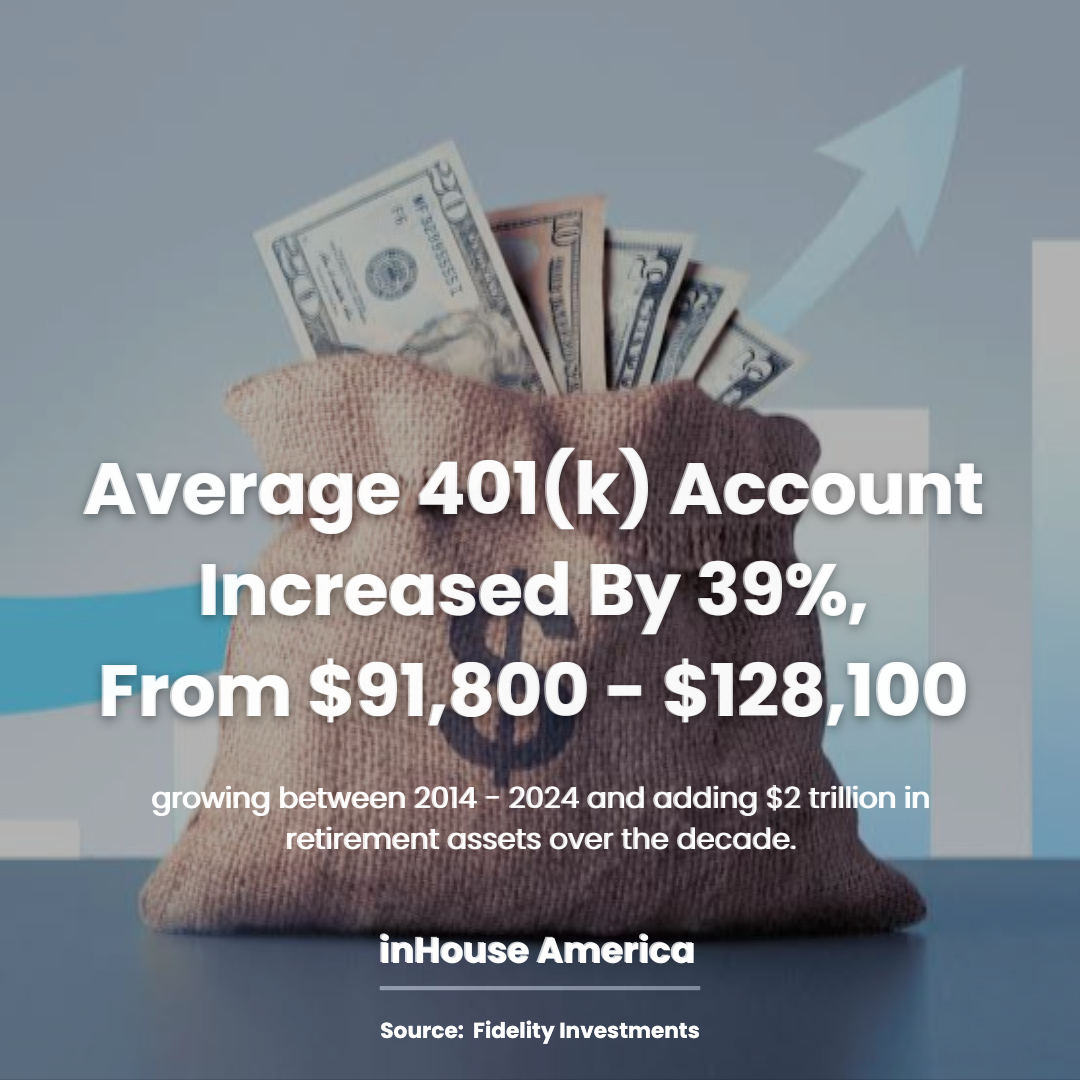InHouse America
Significant Rise in Average 401(k) Balances: 39% Increase Over 10 Years
Published: 17:00 pm (GMT-5), Thu September 5, 2024
3 Minute Read

Source: (Fidelity Investments)
Increased 401(k) Participation
(2014 - 2024)
The number of U.S. workers enrolled in 401(k) plans rose from 53 million to 60 million, reflecting a 13% increase.
Source: (Employee Benefit Research Institute (EBRI) )
Insights: The participation rate grew from 40% of the workforce to 44%, meaning 7 million more workers are actively saving for retirement.
Growth in 401(k) Balances
(2014 - 2024)
Average 401(k) account balances increased by 39%, growing from $91,800 in 2014 to $128,100 in 2024.
Source: (Fidelity Investments)
Insights: This growth resulted in an additional $2 trillion in retirement assets over the decade.
Employer Contributions Boosted Retirement Savings
(2014 - 2024)
The average employer contribution rose to 4.7% of salary by 2024, providing an estimated $250 billion in total contributions.
Source: (Vanguard’s "How America Saves" Report)
Insights: This is up from $180 billion in 2014, equating to a 39% increase.
Roth 401(k) Popularity Surges
(2014 - 2024)
Adoption of Roth 401(k) plans expanded, with 75% of employers offering this option, up from 50% in 2014.
Source: (Vanguard’s "How America Saves" Report.)
Insights: This led to 30 million workers contributing to Roth 401(k) accounts, which hold over $1.2 trillion in assets, a 50% increase in participation.
Policy Changes Provide Flexibility
(2014 - 2024)
New legislation allowed for penalty-free withdrawals during hardships.
Source: (U.S. Department of Treasury)
Insights: Benefiting approximately 5 million participants and reducing penalty costs by $2 billion annually.
Access Inequality
(2014 - 2024)
As of 2024, 33% of the U.S. workforce, primarily low-wage and part-time workers, still do not have access to 401(k) plans.
Source: (U.S. Bureau of Labor Statistics (BLS))
Insights: This affects approximately 50 million Americans, contributing to the $7.1 trillion retirement savings gap.
Low Balances for Many Workers
(2014 - 2024)
Despite growth in average balances, 50% of participants have less than $50,000 saved, making it difficult for many to retire comfortably.
Source: (National Institute on Retirement Security (NIRS))
Insights: Around 30 million workers may struggle financially in retirement without increased savings.
Early Withdrawals Hurt Long-Term Savings
(2014 - 2024)
Early withdrawals increased, with 22% of participants taking hardship withdrawals in 2024, up from 18% in 2014.
Source: (Transamerica Center for Retirement Studies)
Insights: This equates to 13.2 million Americans withdrawing prematurely, reducing future retirement savings by $200 billion and costing them $6 billion in penalties.
Roth 401(k) Underutilization
(2014 - 2024)
Despite its tax benefits, only 25% of eligible workers opted to use Roth 401(k) plans.
Source: (Vanguard’s "How America Saves" Report)
Insights: An estimated 45 million workers could benefit from better financial guidance, which could increase their retirement income by 15%.
Smaller Employer Contributions
(2014 - 2024)
Small businesses contribute an average of 2% of employee salaries to 401(k) plans, significantly lower than the 4.7% offered by larger employers.
Source: (U.S. Small Business Administration (SBA))
Insights: This affects approximately 30% of employees, who miss out on $1,500 annually in retirement contributions.
U.S. 401(K) Growth
(2014 - 2024)
Between 2014 and 2024, the U.S. 401(k) system saw significant growth, with participation rates increasing by 13% and average balances rising by 39% to $128,100. However, 33% of the workforce still lacks access to these plans, and early withdrawals continue to erode retirement security for millions of Americans.
Source: (Fidelity Investments)
Insights: While Roth 401(k) adoption increased, more workers could benefit from its tax advantages with improved financial education. Smaller employer contributions remain a challenge, particularly for employees at small businesses.
InHouse America Final Note
As small businesses make up 99.9% of all U.S. companies, the lower contribution rates and lack of access to retirement plans disproportionately affect the 50 million workers in these sectors.
Source: (InHouse America)
Insights: InHouse America advocates for increased support and financial literacy within the small business community to ensure long-term economic security for all workers.
InHouse America doesn't endorse anyone but focuses on creating awareness of the importance of supporting small businesses and which administration is best for doing so!